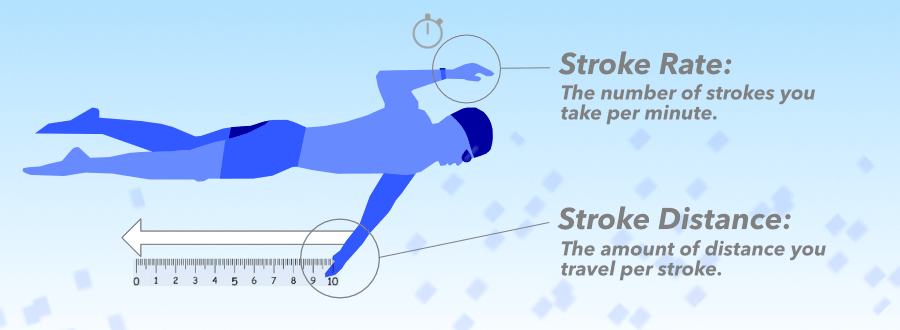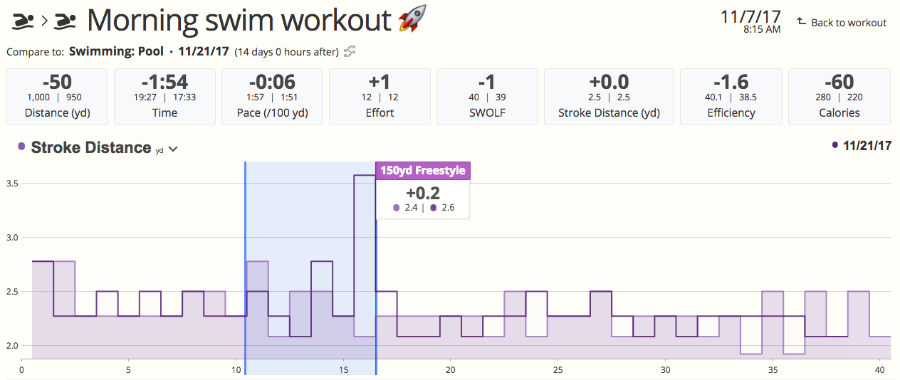What is Stroke Distance?
Improve your SWOLF score by focusing on Stroke Distance
There’s a lot going on in the mechanics of freestyle (forward crawl) swimming: keeping your toes pointed, properly rotating your torso, stretching forward during a pull, etc. Here's one more thing to consider: how far you travel with each stroke. This is a metric called Stroke Distance, and training to optimize it will lower your SWOLF scores and make you a faster, more efficient swimmer.
With all of the measurements involved with swimming, you could easily overlook Stroke Distance completely. But the amount of distance you travel with every stroke is obviously very important. It tells you how much energy you're wasting by just pushing water around — instead of pushing your body forward.
Stroke Distance is also referred to as Distance Per Stroke, or DPS. An important thing to keep in mind is that it varies from person to person. Taller swimmers with longer arms tend to have different numbers compared to shorter swimmers. There isn't a single ideal target to shoot for; it's a personal metric.

How you arrive at your ideal Stroke Distance depends on the type of race you're training for, and the swimming style that best suits you. Some people perform better with more glide time between strokes, while others do not. Ultimately, the most important thing is to figure out what will get you to the finish the fastest.
While there certainly are exceptions to the rule, advanced swimmers tend to take fewer strokes. Therefore, as you analyze your Stroke Distance, you should also keep an eye on your Stroke Rate (the number of strokes you take per minute). The effectiveness of your kick will be a factor here, as the more efficient it is at propulsion, the number of strokes per minute will be smaller.
Reducing drag is key
When it comes to improvement in the water, the topic of drag reduction invariably comes up. Water is 784 times more dense than air, so getting the most distance out of each stroke relies heavily on minimizing drag. As you work to improve Stroke Distance, anything you can do to keep your body as level as possible (head and butt not popping up, legs not sinking down) will help a great deal.
It isn't just about perfecting hydrodynamics. Sculling drills should be incorporated into your weekly training routine. This is the practice of moving through the water using just your hands and forearms for propulsion (no shoulder motion is allowed). You can watch a basic tutorial in a video called How to Do Sculling. These drills will make you more aware of how your body interacts with the water, and help you optimize your catch and hand positioning. And even though it has nothing to do with overall drag reduction, sculling will help improve your form.
It's also beneficial to take your hands out of the equation. You should incorporate weekly drills where you lap the pool with closed-fists. This will force you to concentrate on how your forearms can best be used for propulsion. Alternating between these drills will make you an all-around faster and more efficient swimmer, and you should see an improvement in your Stroke Distance as well.
Post-workout analysis and beyond
Analyzing your workouts after the fact is extremely helpful when training to optimize your Stroke Distance. Software tools like SportTracks help you determine if these training drills are being effective over time. With SportTracks, you can easily compare similar workouts to see if you're making gains.

There is more you can do as you're working out to optimize your Stroke Distance. When you're training in a lap pool and maintaining a specified pace (such as a T-Pace workout), it can be helpful to manually count your strokes with each lap. You will get an immediate sense of how much effort you're exerting to cross the pool. Being able to relate pace with stroke count will give you an informed impression of Stroke Distance, so it will no longer be something abstracted from the workout itself.
Another source of propulsion to consider...
You've likely worked on your catch, pull, and release extensively, but have you ever thought about what's happening above the surface of the water? After a stroke, as your arm exits the water and starts making its way forward for the next catch, it creates kinetic energy that adds to your propulsion through the water. You likely don't want to deviate too far from the standard form of having a relaxed, bent elbow. But, this energy source is still something to keep in mind as you optimize.
Stroke Distance isn't a golden key that unlocks your fastest possible speed in the water. You want to strike a balance between gaining maximum distance per stroke, while still swimming quickly and competitively. There are incremental gains to be made by utilizing the specific training drills in this post. You will travel further with each stroke, bringing your SWOLF scores down and covering more distance with less effort.
| Article written by Sam Mallery, Director of Marketing, Zone Five Software Inc. |
